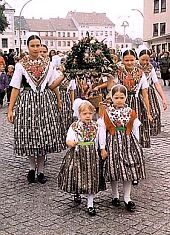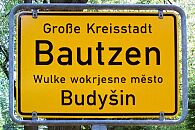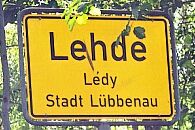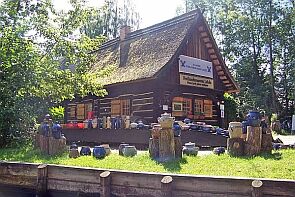|
 Sorbs in German Spreewald
N 51° 52.010 E 013° 59.324
33U E 430370 N 5746710
A slawonic nation in the east of Germany
Waymark Code: WM3AQD
Location: Brandenburg, Germany
Date Posted: 03/06/2008
Views: 119

Unbeknown to most, there are four small indigenous nations within the borders of Germany. They have lived here for thousands of years, preceding German settlements, and have preserved their unique language, religion and culture throughout the centuries. They enjoy special constitutional rights like the preservation and use of their language and their own elected representatives in local and state governments.
The four nations are the Sinti & Romani, the Frisians, the Sydslevik and the Sorbs. Although there are certain areas in which the members of these nations traditionally live, there are no distinct boundaries and no reservations. Even in their traditional homelands they are vastly outnumbered by the German majority so, posting them within this waymark category might prove difficult.
There is, however, one exception: the Spreewald, the heartland of the Lusatian Sorbs. Here the Sorbs build the majority of the people and a journey to Lehde, the central settlement in Spreewald really is like a journey to a foreign country.
|

 |
Spreewald Sorbs
The Sorbs are a small Slavonic nation that never had a state of their own. Over the last thousand years, they were ruled by Swedish, Polish, Bohemian, Austrian and German kings at one time or another. While Sorbian population in nearby cities suffered severely under foreign domination, the swamps and wetlands of the Spreewald delta were so inaccessible that neither Wallenstein’s soldiers in the 30-Years War of the 1500s, nor Napoleon’s troops in the 1800s, and not even the Russian tanks in World War II left a scar. The Spreewald-Sorbs lived mostly undisturbed and brought a unique culture with beautiful legends and colorful rituals into the 21st century.
|

 |
While there are no distinct boundaries to Sorbian territory, there is one clear way to tell: it is the only part of Germany with bilingual signs. |

|
Bautzen (German) / Budyšin (Sorbian)
Seat of the Sorbian parliament, the domowina.
Picture curtesy of Wikipedia. |
Lehde (German) / Lédy (Sorbian)
Cultural center of the Sorbian people.
Picture taken by the author.
|


|
Living in swamps and wetlands, the life of the Sorbs is full of mythical figures such as water spirits and ghost lights. The roof tops of Sorbian houses are always topped with the image of a crowned snake – in Sorbian legends the snake king is the protector of homes and families. Some places receive special protection by large wooden carvings, almost looking like Native American totem poles.
|

 |
As main coordinates, we have chosen the center of Lehde. Lehde, or Lédy in Sorbian, is the cultural center of the region. Don’t miss the two museums, the Spreewald Museum and the world’s only Pickle Museum. (See coordinates below).
|
Both museums offer a colorful insight into the traditional life of this small nation.
Check out our museum waymark.
|
Type of Nation Within: Other

Tribe or Band: Sorbs

Address of Main Entrance to area:
Spreewaldmuseum Lübbenau / Lehde
Am Topfmarkt
Lübbenau / Spreewald, Brandenburg Germany
03222

Land Area - Specify Acres or Miles: 187 square miles

Population: 60,000

Open or Closed to Public: Open To Public

Website for further information: [Web Link]

Coordinates of site within area to visit: N 51° 52.015 W 013° 59.472

Date when area was established or set aside: Not listed

|
Visit Instructions:
Only one waymark per area (reservation) will be accepted, although you may log visits anywhere within the reservation because they oftentimes cover a large area. To log a visit to the waymark, please provide a photo of signage recognizing the area and a photo from within the area.
|